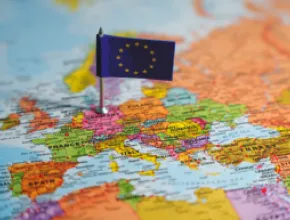At International Pow Wow, an annual U.S. travel industry trade show, international attendees are central to the show’s main mission: to sell domestic leisure travel to foreign buyers.
About 1,200 travel buyers from more than 70 countries attend Pow Wow, which was held last May in San Francisco and is now in its 43rd year. The buyers typically consist of tour operators and travel wholesalers who sell travel products like packaged vacations to retailers, and travel agents and tour operators who sell directly to the public.
In addition, some 400 travel news media representatives, three-quarters of whom come from outside the U.S., also attend the five-day show. More than 1,000 companies and organizations throughout the country, such as hotels, tourist attractions and convention bureaus, exhibit at Pow Wow. Altogether, about 5,000 people attend the show each year.
Unlike a lot of other trade shows, Pow Wow is an invitation-only event, with buyers and journalists hosted to varying degrees by the show’s owner and organizer, U.S. Travel Association. So getting people to attend Pow Wow is not a problem for U.S. Travel. Getting the right kind of people to attend—namely people who will book business during the show—is the challenge.
Toward that end, U.S. Travel has set up committees in foreign countries to vet and ultimately invite attendees. The committees consist of volunteers who are travel professionals in their own country and thus presumably most knowledgeable about the best people to invite. Candidates are judged mainly on the volume of visitors they send to America, according to Barbara Logan, vice president of meetings and events for U.S. Travel.
Attendees register through U.S. Travel’s show website, powwowonline.com. The registration software is custom-built, according to Logan, primarily because the show is organized around scheduled meetings of buyers and exhibitors rather than attendees simply walking the show floor. Some 70,000 business meetings take place during Pow Wow, so sophisticated software is needed to handle all that scheduling and to integrate registration and scheduling into a seamless system to encourage more business meetings.
Although Logan and her staff of seven tweak their procedures from show to show, this year Logan switched to an outside housing bureau to handle hotel reservations rather than devote a single staffer to the task.
“We’ll probably do it again next year,” Logan says of the housing bureau, explaining that attendee changes in room reservations consume too much staff time.
U.S. Travel typically reserves about 3,600 rooms on peak night, and this year in San Francisco the group reserved room blocks in 20 hotels, according to Logan.
Logan calls reserving rooms for attendees from so many different countries “a puzzle we work with every year.” She tries to cluster attendees into hotels by country, as same-country attendees constitute a single delegation. Moreover, same-country delegates usually prefer staying together.
“Especially in countries where English is not commonly spoken, attendees can help each other,” Logan explains, adding that U.S. Travel staff works with the contracted hotels to identify hotel employees who speak the delegates’ language.
Logan also assigns delegations to hotels in an attempt to expose the delegates to the range of domestic hotel products over successive shows.
“It’s fair to the U.S.-supplier hotels to share delegations and to provide delegates the opportunity to see different brands,” she says.





